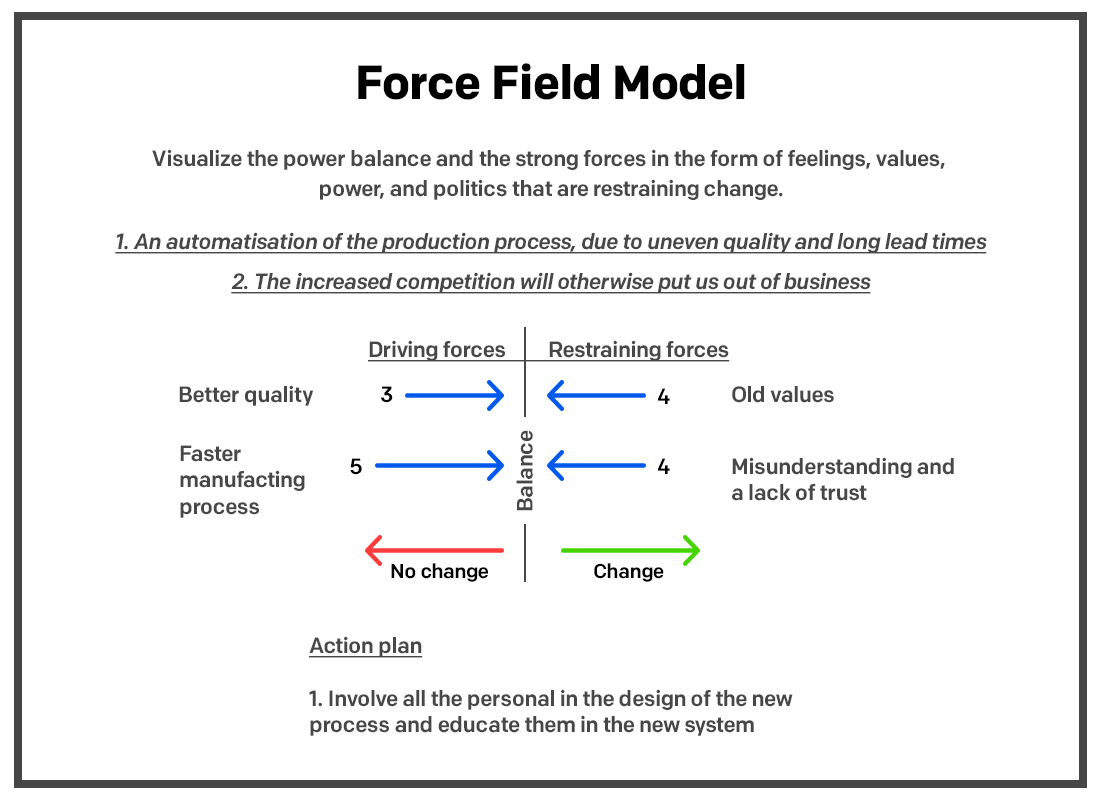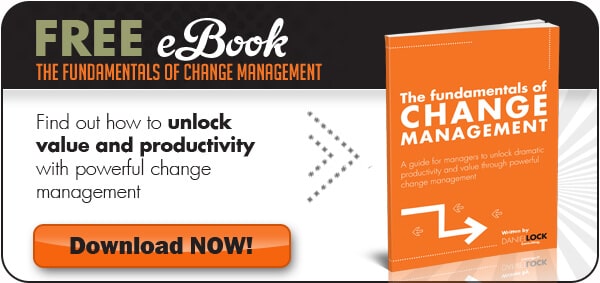Change management can be challenging, but it is a well-trodden path.
People have thought about it hard and come up with models that work.
In this post, I’ll look in depth at Kurt Lewin’s change model and the insights for actionable change it offers.
Known as one of the modern pioneers in social, organizational and applied psychology, Kurt Lewin, a German-American psychologist (born in Poland in 1890), was a professor at the University of Berlin between 1926 and 1932 before moving to the United States in 1933.
Lewin worked as a professor in a number of US universities before eventually becoming director of the Center for Group Dynamics at Massachusetts Institute of Technology (MIT).
Free download Kurt Lewin Change Management Powerpoint Slide Template. These slides are easily customizable, helping you implement change management for maximum success.
Download the Bonus
Plus: Get Access to my Free 7 part Email Course on “Introduction to Leading Change.”
Lewin’s model of change
In the 1940s, Lewin proposed a Change Management Model that was perhaps, the first and most famous early analysis of how organizations adapt and deal with change. Later William Bridges proposed a similar 3 stage model of change.
Kurt Lewin’s change theory proposed three main stages to move an organization from its current state to a desired future state: “Unfreeze – Change – Refreeze”



- Unfreeze – Creating a sense a change is needed
- Change – Moving towards a new and desired behavior
- Refreeze – Setting this behavior as the new normal
It is lauded even by more modern organizational gurus such as Edgar Schein, who says: “I am struck once again by the depth of Lewin’s insight and the seminal nature of his concepts and methods . . . [they] have deeply enriched our understanding of how change happens and what role change agents can and must play.” (Schein, 1996: 46)
Kurt Lewin’s change theory used blocks of ice as a metaphor.
Let’s say you have ‘cube’ of ice but you’d like a ‘cone’ of ice. To transform the cube shape you must:
- “unfreeze” or melt the ice
- “change” the mould to a cone shape and
- “refreeze” the water into the new, desired shape
It’s a simple three-stage process that allows you to easily diagnose which stage you are in.
As Lewin put it, “Motivation for change must be generated before change can occur. One must be helped to re-examine many cherished assumptions about oneself and one’s relations to others.”
Kurt Lewin’s change theory identified several golden rules (1951) on how change is to be implemented:
- Change should only be implemented for good reason.
- Change should always be gradual.
- All change should be planned and not sporadic or sudden.
- All individuals who may be affected by the change should be involved in planning for the change.
Now, we’ll look at each of the three stages in more depth and see how these ‘golden rules’ apply.![]()

Stage 1: Unfreeze
The ‘Unfreeze’ stage is about creating the motivation to change.
Motivation is intrinsic to an individual.
I cannot motivate you. You cannot motivate me. But I can create the conditions, messages, and environment that may influence you to want to change.
In this stage, Lewin’s change model asks us to examine the “way things are done around here” (assumptions) and challenge the status quo.

Force-field analysis – Lewin (1951)
Lewin’s change model suggested a methodology for analyzing change he called the ‘force field analysis’. Essentially, this involved the following:
- analyze the restraining or driving forces that will affect the transition to the future state – restraining forces include the reactions from those who see change as ‘unnecessary’ or constituting a ‘threat’.
- assess driving or restraining forces – which ones are critical?
- take steps to increase the critical driving forces + decrease the critical restraining forces.
Source: Lewin, K (1951) Field Theory in Social Science, Harper & Row, New York


Stage 2: Change
The ‘Change’ stage has a focus on the solution – new ways of working. It begins with new approaches to problems. With new approaches comes new learning and it takes place here:
- Goals are established.
- Smaller, acceptable changes that reinforce and support change are instituted.
- Management structures are developed.
- Open, two-way communication (dialogue) is maintained.
This stage requires active stakeholder participation (particularly, with those impacted by the change).

Stage 3: Refreeze
The ‘Refreeze’ stage calls for “institutionalizing” these new ways of acting and working.
New attitudes, values, and behaviors are established as the new status quo. Staff will begin to feel confident and comfortable in this new world.
Until the next cycle, that is.
Free download Kurt Lewin Change Management Powerpoint Slide Template. These slides are easily customizable, helping you implement change management for maximum success.
Download the Bonus
Plus: Get Access to my Free 7 part Email Course on “Introduction to Leading Change.”
Why are these steps so important?
Let’s look at this scenario to explain why these three steps are so important.
Skip-a-step scenario
Let’s imagine you skip the ‘unfreezing’ phase and go straight to the ‘change’ phase.
What will happen?
The change will meet resistance.
Why?
Prevailing forces such as old values begin to increase to counter the change. This leads to misunderstandings and a lack of trust (use the Force Field Analysis model to visualize this scenario)!
When you are making the actual change, important knowledge and/or internal acceptance may be lacking and suggestions ill-founded if you don’t:
- base your decisions on a rigorous and systematic process (hunches yielding a ”good enough” outcome just won’t cut the mustard); and
- involve all who are concerned by the change.
Criticisms
Overly simple?
The main criticism of Lewin’s change model is that it is quaint and too simple for the modern era of constant and rapid change.
The ‘Refreeze’ stage, in particular, implies a great deal of time is spent in the new status quo.
However, even in our current era of high speed and frequent change, we must have some degree of ‘refreeze’, otherwise we would “get caught in a transition trap where they aren’t sure how things should be done”. As a result, we would not be able to perform at appreciable standards let alone best capacity.
Lewin’s model is often criticized as linear and without consideration for emotional life as people journey through change.
Where is leadership in all this?
Still, other critics claim Lewin’s model does not discuss leadership as a factor at all.
Perhaps, the mid-twentieth century world was more command-and-control and was less obvious was any talk of leadership. Indeed, leadership as research for organizational theorists didn’t begin until the 1960’s and 1970’s.
There is also the distinction between change management and organizational development to consider, too. Where the latter, OD, tackles leadership in a strategic sense.
Western-centric?
A criticism of change management models, in general, is that organizational development and other such change approaches are typically western or US-centric models. Perhaps, these cannot be applied in the same way across all cultures.
Presumably, these models are not suited to the following situations:
| Focuses on: | High rankings indicate: | |
| High Power Distance |
|
|
| High Uncertainty Avoidance |
|
|
| High Masculinity Cultures |
|
|
The following table outlines cultural archetypes across ten countries:

In summary …
The criticisms of simplicity and lack of leadership may actually be the strength of the Lewin model. True, change management is complex, but simplifying it makes it easier for people to take action where uncertainty can paralyze any action altogether. Regarding leadership, it is a key determinant of change success, but a model that emphasis broad based change is certainly empowering to the individual.
Whatever the criticisms many change management models that followed Lewin’s change model have their roots in, and were inspired by his ideas.
Applying Lewin’s Change Model
Free download Kurt Lewin Change Management Powerpoint Slide Template. These slides are easily customizable, helping you implement change management for maximum success.
Download the Bonus
Plus: Get Access to my Free 7 part Email Course on “Introduction to Leading Change.”
![]() Step 1 – Unfreeze
Step 1 – Unfreeze

| Actions | |
|
|
|
|
|
|
![]() Step 2 – Change
Step 2 – Change

| Actions | |
|
|
|
|
|
|
|
|
![]() Step 3 – Refreeze
Step 3 – Refreeze

| Actions | |
|
|
|
|
|
|
Finally, no matter what model you use and how diligent you follow the steps, change takes time. It can be ambiguous and mistakes happen.
You’ll need a lot of grit.
And the final word is – keep taking action with commitment and diligence. You’ll get there in the end!




Very good information .
i’m studying DBA, teacher ask me to solve probem kurt lewin’s mondel. thank you for your ppt in advance.